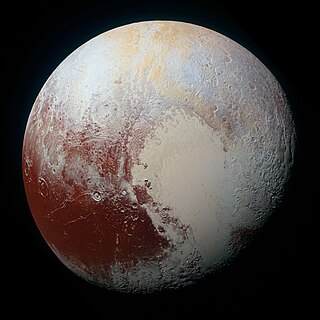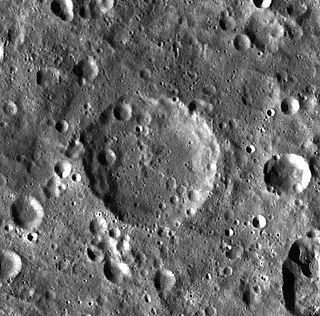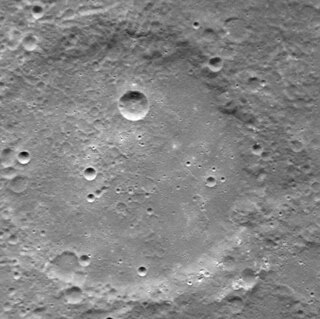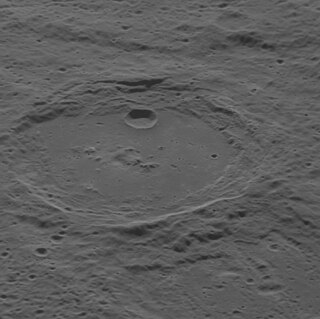
Planetary nomenclature, like terrestrial nomenclature, is a system of uniquely identifying features on the surface of a planet or natural satellite so that the features can be easily located, described, and discussed. Since the invention of the telescope, astronomers have given names to the surface features they have discerned, especially on the Moon and Mars. To found an authority on planetary nomenclature, the International Astronomical Union (IAU) was organized in 1919 to designate and standardize names for features on Solar System bodies.

Apollo, also called the Apollo basin, is a large impact crater located on the far side of the Moon, in the southern hemisphere. It was previously known as Basin XVI; in 1970 it was officially named after the Apollo missions by the International Astronomical Union.

Chevallier is a lunar impact crater that is located in the northeastern part of the Moon's near side, about a crater diameter east-southeast of the prominent crater Atlas. To the south-southeast of Chevallier is the flooded crater Shuckburgh. Chevallier was named by the IAU in 1935.

Freundlich is a lunar impact crater that is located on the far side of the Moon. It lies midway between the craters Trumpler to the north-northwest and the irregular Buys-Ballot to the south-southeast. This crater has a circular rim that is more heavily eroded at the northern and southern ends. Groups of craters lie across the floor to the southeast and the north, and individual small craters lie elsewhere within the interior. The crater was named after Erwin Freundlich by the IAU in 1970.

Africanus Horton is a circular impact crater on Mercury. It was named by the IAU in 1976, after Africanus Horton, a Creole African nationalist writer and an esteemed medical surgeon in the British Army from Freetown, Sierra Leone.

Sholem Aleichem is a crater on Mercury, named after the Yiddish writer Sholem Aleichem in 1979. The inter-crater plain deposits have been deformed by linear ridges.

Matisse is an impact crater on the southern hemisphere of Mercury. Matisse takes its name from the French artist Henri Matisse, and it was named by the IAU in 1976.

Qi Baishi is a crater on Mercury. The crater was named after famed Chinese painter Qi Baishi. The crater has an asymmetric pattern of ejecta rays, which formed by an object traveling to the east or to the west and impacting Mercury's surface at a very low incidence angle. However, Qi Baishi crater is still roughly circular, which is in contrast to the elongated shape of neighboring Hovnatanian crater.

Donne is a crater on Mercury. It has a diameter of 86 kilometers. Its name was adopted by the International Astronomical Union (IAU) in 1976. Donne is named for the English poet John Donne, who lived from 1572 to 1631.

Hauptmann is a crater on Mercury. It has a diameter of 118 kilometers. Its name was adopted by the International Astronomical Union (IAU) in 1985. Hauptmann is named for the German playwright Gerhart Hauptmann, who lived from 1862 to 1946.

Martial is a crater on Mercury. It has a diameter of 51 kilometers. Its name was adopted by the International Astronomical Union in 1979. Martial is named for the ancient Roman poet Martial, who lived from 40 to 103.

Mussorgskij is a crater on Mercury. Its name was adopted by the International Astronomical Union (IAU) in 1979. Mussorgskij is named for the Russian composer Modest Mussorgsky, who lived from 1839 to 1881. The crater was first imaged by Mariner 10 in 1974.

McLaughlin Crater is an old crater in the Oxia Palus quadrangle of Mars, located at 21.9°N 337.63°E. It is 90.92 km (56.50 mi) in diameter and 2.2 km (1.4 mi) deep. The crater was named after Dean B. McLaughlin, an American astronomer (1901-1965). The Mars Reconnaissance Orbiter has found evidence that the water came from beneath the surface between 3.7 billion and 4 billion years ago and remained long enough to make carbonate-related clay minerals found in layers. McLaughlin Crater, one of the deepest craters on Mars, contains Mg-Fe clays and carbonates that probably formed in a groundwater-fed alkaline lake. This type of lake could have had a massive biosphere of microscopic organisms.

Villa-Lobos is a crater on Mercury. Its name was adopted by the International Astronomical Union (IAU) on September 25, 2015. Villa-Lobos is named for the Brazilian composer Heitor Villa-Lobos.

Anguissola is a crater on Mercury. It has a diameter of 35.41 kilometres. Its name was adopted by the International Astronomical Union (IAU) on August 4, 2017. Anguissola is named for the Italian painter Sofonisba Anguissola.

Flaiano is a crater on Mercury. It has a diameter of 43 kilometres. Its name was adopted by the International Astronomical Union (IAU) on March 15, 2013. Flaiano is named for the Italian writer Ennio Flaiano.

















